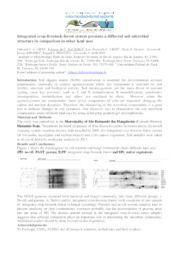Integrated crop-livestock-forest system presents a different soil microbial structure in comparison to other land uses.
Integrated crop-livestock-forest system presents a different soil microbial structure in comparison to other land uses.
Author(s): LEITE, D. C. A.; BALIEIRO, F. de C.; LEITE, L. F. C.; MADARI, B. E.; RIBEIRO, A. de F.; PEIXOTO, R. S.; ROSADO, A. S.
Summary: Soil organic matter (SOM) conservation is essential for environmental services maintenance, especially in tropical agroecosytems where this component is essential for soil fertility, structure and biological activity. Soil microorganisms are the main driver of nutrient cycling, since key processes, such as C and N mineralization, N immobilization, xenobiotics decomposition, denitrification and others are mediated by them. However when the agroecosystems are manipulated, these active components of soils are impacted, changing the carbon and nutrient dynamics. Therefore, the monitoring of the microbial communities is a good tool to indicate changes in soil dynamics. Our objective was to characterize the soil microbial communities under different land uses by using denaturing gradient gel electrophoresis.
Publication year: 2015
Types of publication: Abstract in annals or event proceedings
Unit: Embrapa Soils
Keywords: Microbiologia do solo, Uso da terra
Observation
Some of Embrapa's publications are published as ePub files. To read them, use or download one of the following free software options to your computer or mobile device. Android: Google Play Books; IOS: iBooks; Windows and Linux: Calibre.
Access other publications
Access the Agricultural Research Database (BDPA) to consult Embrapa's full library collection and records.
Visit Embrapa Bookstore to purchase books and other publications sold by Embrapa.

